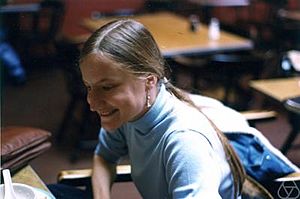Jean A. Larson facts for kids
Quick facts for kids
Jean A. Larson
|
|
|---|---|
 |
|
| Alma mater | University of California, Berkeley, Dartmouth College |
| Scientific career | |
| Institutions | University of California, Los Angeles, University of Florida |
| Doctoral advisor | James Earl Baumgartner |
| Influences | John W. Addison Jr. |
Jean Ann Larson is an American mathematician who studies numbers and patterns. She is an expert in set theory, which is about collections of things. She also studies the history of mathematical logic, which is like the rules of math. Dr. Larson is a professor at the University of Florida.
She made history as the first woman to earn a special math degree called a doctorate from Dartmouth College. She is famous for her work in infinitary combinatorics, which looks at patterns in very large, endless sets of numbers. She also studies the theory of linear spaces, which are like special geometric shapes.
Contents
Becoming a Mathematician
Jean Ann Larson grew up in the San Francisco Bay Area in California. In 1968, she finished her bachelor's degree in mathematics at the University of California, Berkeley. She also studied English.
From Teacher to Math Expert
When she was in college, Jean thought she would become a teacher. But a professor at Berkeley, John W. Addison Jr., saw how good she was at math. He encouraged her to continue her studies and become a math researcher.
Making History at Dartmouth
Jean went on to get her Ph.D. in mathematics from Dartmouth College in 1972. Her professor was James Earl Baumgartner. When she earned her degree, she became the very first woman to get a math Ph.D. from Dartmouth. This was a big achievement!
Teaching and Leadership
After finishing her Ph.D., Dr. Larson worked as a professor at the University of California, Los Angeles from 1972 to 1974.
Life at the University of Florida
Since 1974, she has been a professor at the University of Florida. She became a full professor there in 1987. From 1993 to 1996, she helped lead the graduate studies program. In 2002, Dr. Larson became the head of the faculty senate at the University of Florida. She believes her Quaker faith helped her become a good listener. This skill helped her bring people together and lead the university.
Exploring Math Concepts
Much of Dr. Larson's work is in infinitary combinatorics. This field studies different versions of Ramsey's theorem for infinite sets. Infinite sets are collections of things that never end.
Her Early Research
Her Ph.D. paper, called On Some Arrow Relations, was about this topic. People in math say she is a "prominent figure" in how numbers are divided into groups. She is especially good at understanding how numbers relate to each other in endless sequences.
Working with Paul Erdős
Dr. Larson worked with Paul Erdős on five different research papers. He was a very famous mathematician who studied patterns in numbers. Erdős visited Dr. Larson and other mathematicians at the University of Florida every year from 1973 to 1996. He would stay for two weeks each time.
Drake–Larson Linear Spaces
In the study of linear spaces, there are special shapes called Drake–Larson linear spaces. These are named after Dr. Larson and her colleague, David A. Drake. These spaces are made of points and lines. They have rules like:
- Every line has at least two points.
- You can draw a line through any two points.
- Not all points are on the same line.
What makes Drake–Larson spaces special is that none of their lines have exactly two, three, or six points. If such a space exists, it can help create certain kinds of Latin squares. Latin squares are like puzzles where numbers or symbols appear only once in each row and column.
In 1983, Drake and Larson figured out how many points these spaces could have. There was only one mystery left: spaces with exactly thirty points. This puzzle remained unsolved for many years. Then, in 2010, two mathematicians named Betten and Betten finally solved it.

